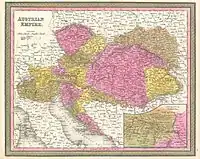Austrians of Croatia
Austrians of Croatia are officially recognized as a minority in the Republic of Croatia, and therefore have their own permanent seat in the Croatian Parliament.
| Total population | |
|---|---|
| 297[1] | |
| Languages | |
| Croatian, German | |
| Religion | |
| Roman Catholicism | |
| Related ethnic groups | |
| Germans |
History

Austrians first began settling in Croatia as military personnel after the Croatian nobles met in Cetin to elect Ferdinand I, Archduke of Austria as their king,[2] and in return the Habsburgs would defend Croatia from the Ottoman invasion.[3] This led to the creation of the Military Frontier (Vojna Krajina, German Militaergrenze) within Croatian territory which would be ruled directly from Vienna's military headquarters.[4] This led to an increase of Austrian and other settlers and military elite within the Military Frontier. In 1815, the Habsburgs finally secured possession of Dalmatia and Istria after the fall of Venice. In time the Austrian elite began flocking to the Adriatic for holiday and sunbathing. Towns such as Opatija gained reputations as health resorts and became populated by mainly Austrian season-goers.
Geographic representation
According to the 2001 census, there are 247 people who consider themselves Austrians, with the largest group (21.8% of Croatia's ethnic Austrians) residing in Zagreb.[5]
| County | Number of Austrians |
Percent of total |
|---|---|---|
| City of Zagreb | 53 | 21.8% |
| Primorje-Gorski Kotar | 36 | 14.8% |
| Istria | 26 | 10.5% |
| Osijek-Baranja | 36 | 9.3% |
| Split-Dalmatia | 18 | 7.3% |
| Dubrovnik-Neretva | 13 | 5.3% |
| Zadar | 13 | 5.3% |
| Međimurje | 10 | 4.1% |
Notable individuals
- Gordon Schildenfeld, Croatian football player
External links
See also
References
- "Stanovništvo prema narodnosti, popisi 1971. - 2011" (in Croatian). Retrieved 21 December 2012.
- R. W. SETON -WATSON:The southern Slav question and the Habsburg Monarchy page 18
- Milan Kruhek: Cetin, grad izbornog sabora Kraljevine Hrvatske 1527, Karlovačka Županija, 1997, Karlovac
- Charles W. Ingrao:The Habsburg monarchy, 1618–1815 page 15
- Croatia Census 2001
